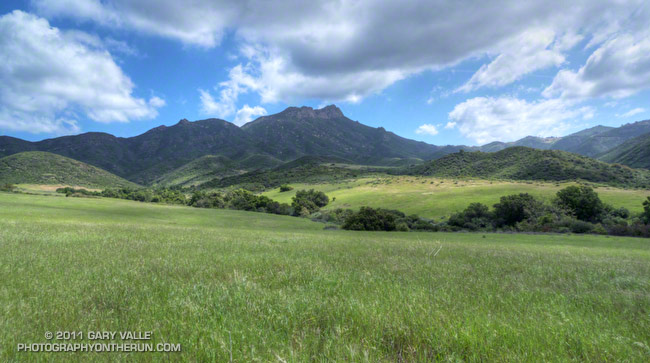
Serrano Valley near the start of the southern leg of the Serrano Valley Loop Trail, in Pt. Mugu State Park.
From Sunday’s Boney Mountain – Serrano Valley loop.

Serrano Valley near the start of the southern leg of the Serrano Valley Loop Trail, in Pt. Mugu State Park.
From Sunday’s Boney Mountain – Serrano Valley loop.
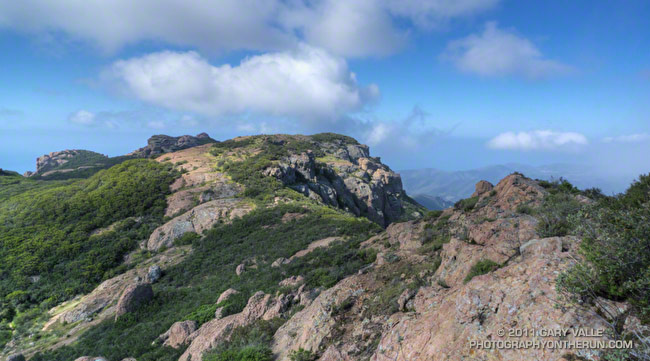
The Wendy Dr. trailhead in Newbury Park is a gateway to some of the most scenic and spectacular trail runs in the Santa Monica Mountains. Runs, hikes and rides on the extensive and diverse network of trails can range from a few minutes, to many miles and hours.
Today my run was of the “few hours” variety. The weather in Pt. Mugu State Park was perfect for a longer run — partly cloudy, light winds, and the temperatures ranged from the high 40s in the morning to the high 60s midday.
La Nina or El Nino, rain seasons as wet as the 2010-11 season are relatively rare. The wet weather produces a cascade of effects, resulting in conditions that might not be seen again for years. Streams that had not run for years were flowing; numerous wildflowers were blooming; the chaparral and other plant communities, and their inhabitants, were flourishing. I did not want to miss anything.
With that thought in mind, my route took me up and over Boney Mountain and Tri Peaks to the Backbone Trail, and then down the Chamberlain Trail and Old Boney Trail to the Serrano Valley Trail. After running through resplendent Serrano Valley, I continued down Serrano Canyon, crossing the creek 15 times, all the while trying to avoid the lush growth of poison oak along the trail. Even the miles returning up Sycamore Canyon were enjoyable, and involved a few stream crossings. The Upper Sycamore Trail and Danielson Road led back to Satwiwa and the trailhead.
On this particular day it was as fine a trail run as I have done, and probably the most scenic loop I’ve done in the Santa Monica Mountains.
Some related posts: Western Rim of Boney Mountain, Conejo Valley Sun and Boney Mountain Clouds
Here are a few additional photographs from the run:
|
|
|
|
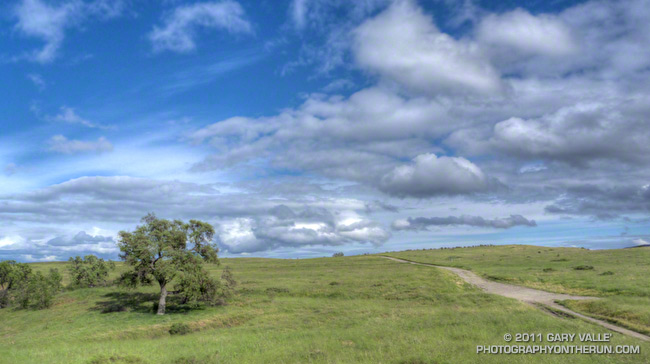
Follow the wind,
Run to the sky.
Find what you’re searching for,
Near or far.
Even in Southern California, Spring can be a fitful beast. This afternoon the temperature was in the low 50s, and the wind was blowing hard enough it was difficult to take a photograph. Just one week ago it had been a stifling 95 degrees — a temperature swing of more than 40 degrees.
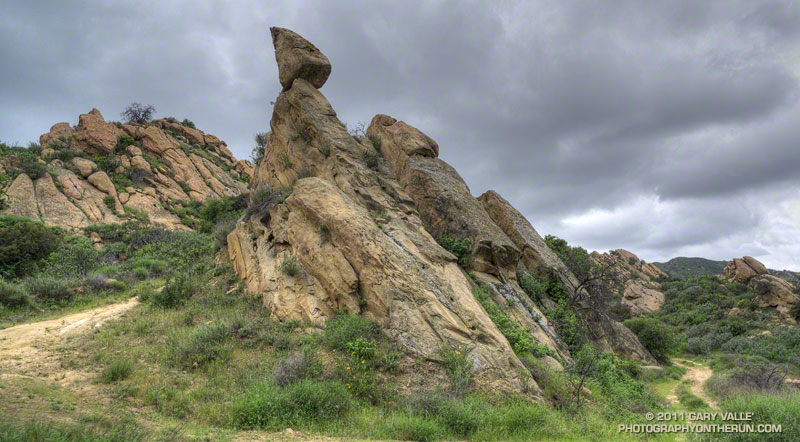
This weekend I decided to give my legs a break and instead of 9 pounds per foot of ski, binding, boot and climbing skin, treated them each to 13 ounces of running shoe. I was thinking about it the other day — skiing up San Jacinto with my tele gear is a little like strapping two 5 lb. bags of sugar to each foot, going up to (on average) 9,500 feet, and then climbing 4,000 or so stairs. I either need to get lighter gear, or go back to using my Europa 77s!
Today’s run was an elongated loop through one of the more isolated and rustic areas of upper Las Virgenes Canyon. From the Las Virgenes trailhead of Upper Las Virgenes Canyon Open Space Preserve the 14.5 mile route followed upper Las Virgenes Canyon and Bell Canyon roads to the overgrown (and easy-to-miss) single track that leads to the west and connects to the Edison powerline service road. This Park Service PDF includes a map of the area, and this interactive Cesium browser View shows a trace of my route.
After climbing up and over a rocky ridge and down to the junction with the Sheep Corral Trail, the service road continues south along Cheeseboro Ridge all the way back to the Las Virgenes Canyon trailhead. With all the rain, and recent warm weather, Spring was happening in a big way in the chaparral. Over the course of the run I photographed nearly 40 species of plants that were in bloom. Here are a few of the wildflowers:
|
|
|
|
Related post: Upper Las Virgenes Canyon Backcountry
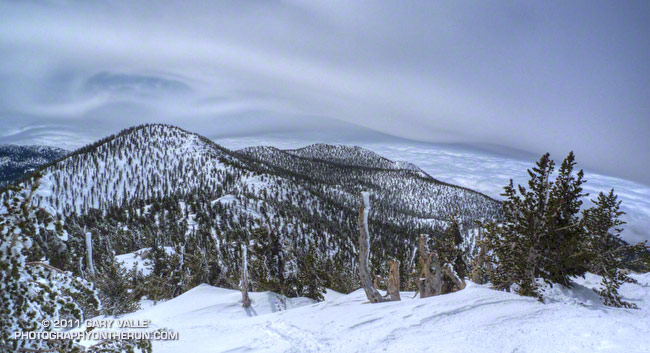
After last Sunday’s record-setting storm in Southern California, and the cool, unsettled weather during the week, we expected snow conditions on Mt. San Jacinto to be even better than on previous trips this March. But snow conditions — especially backcountry snow conditions — aren’t always what you expect. The new snow, maybe a foot of it, was as thick as wet concrete. If we’d had a little kiwi fruit flavoring, it would have been perfect for shave ice.
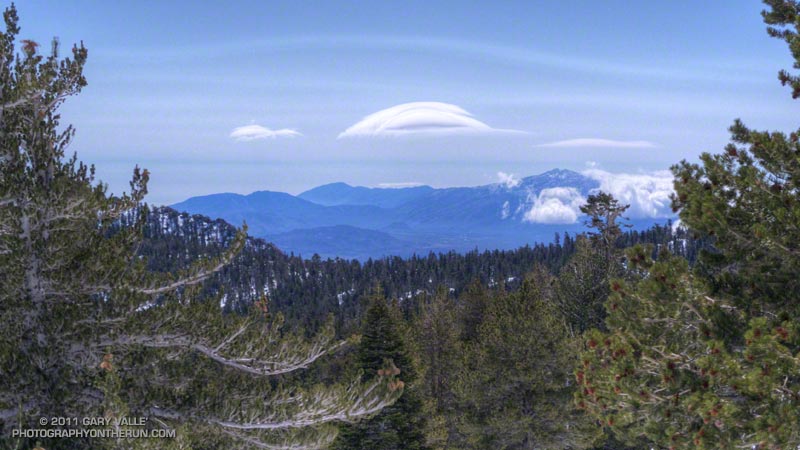
Even if the snow wasn’t what we had hoped for, the day was extraordinary. Another weak front was moving into Southern California and the strong onshore flow ahead of the front was creating several kinds of interesting mountain weather phenomena — some common and some not so common.
Riding up the tram, we could see plumes of dust blowing across the desert floor east of Banning Pass, and a stack of lenticular clouds hovered over the mountains east of San Gorgonio Mountain. It was breezy at the upper tram station, and from the walkway descending to Long Valley, we could see rimed trees on the southeast side of San Jacinto Peak.
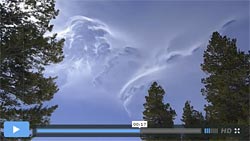
We skied up a beautiful untracked drainage south of the Round Valley trail, and eventually worked our way over to Long Valley Creek and then to Tamarack Valley. We were almost to the top of the steep step above Tamarack Valley, and had paused for a moment to look around. There was a distinctive wave cloud to the southeast, and the lower cloud deck was beginning to engulf Toro Peak (8716′). I turned to continue up the slope, and as I looked up, the first of a series of tumbling and twining filaments of gossamer cloud swept past in the turbulent west-northwest flow (video).
Six months ago, also before the passage of a cold front, I’d seen similar clouds on Boney Mountain, in the Santa Monica Mountains. In that case and here on San Jacinto, a moist layer in a stably stratified westerly flow was being lifted over a mountain range. Depending on whether the flow remained laminar, or became transitional or turbulent; a wave cloud, transient wave cloud, or these turbulent thin sheets of cloud might form. In each case the atmosphere was becoming more moist and the clouds were precursors to the formation of a more widespread and persistent cloud layer.
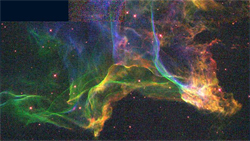
These vaporous, turbulence-induced clouds bear a striking resemblance to interstellar molecular clouds. Both appear to occur in a high-Reynolds-number regime, and each appears to consist of a cohesive, thin sheet of condensate that can be stretched, sheared, undulated and torn. As in the case of its interstellar counterpart, when viewed edgewise, the clouds look like they are comprised of thin, web-like filaments.
The title photo was taken a little below the summit, after ascending the peak. It’s a view to the south, past Jean Peak (10,670′) and Marion Mountain (10,362′), and shows the terrain induced uplift, waves, and turbulence over the San Jacinto mountain range. The flow is from the right to left.
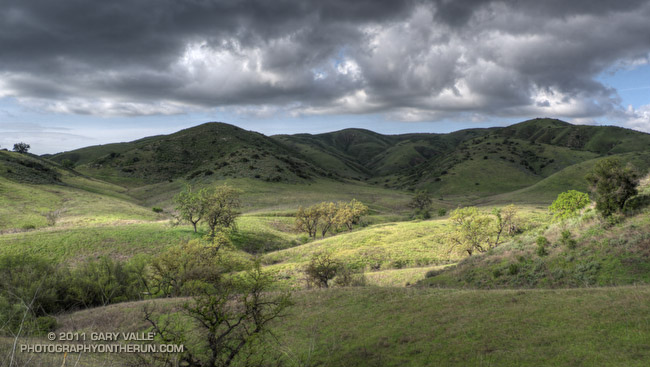
It has been a remarkable rain season in Southern California. December 2010 was the wettest December in Los Angeles in 121 years. Then Sunday, an exceptionally strong system produced record-setting rainfall in Los Angeles, Ventura, Santa Barbara, and San Luis Obispo counties with some locations recording as much as one-third of a year’s normal rainfall in 24 hours!
Runners in the Los Angeles Marathon had to contend with rain, wind and cool temperatures. Of 19,763 runners, more than 10,000 were on the course for longer than 5 hours. According to a report in the Los Angeles Times sports blog, The Fabulous Forum, thousands of runners were evaluated for hypothermia, but only 25 runners were hospitalized.
Sunday evening rain rates in excess of an inch an hour were recorded in several areas, and a flash flood was reported in Woodland Hills with “mud and debris flowing down the street” and “at least four to five vehicles stuck in flowing water.” Downtown Los Angeles (USC) recorded 2.42 inches of rain Sunday, breaking a record set in 1943. Santa Barbara Airport had its wettest day on record, recording 5.23 inches of rain. Here’s an archived copy of the NWS Record Report for March 20, listing some of the rainfall records for the day.
Some phenomenal rainfall amounts were recorded over the course of the storm. Van Nuys recorded 6.74 inches of rainfall, Northridge 6.08 inches, Newhall 7.20 inches, Camarillo 5.58 inches, Rose Valley 10.99 inches, Montecito Hills 7.70 inches, San Marcos Pass 10.72 inches, and Gibraltar Dam 11.73 inches. Here’s an archived copy of a NWS report with some rainfall and snowfall totals for the storm.
Downtown Los Angeles increased its water year rainfall total to 18.55 inches, or about 123% of normal. This makes the 2010-2011 water year the wettest in Los Angeles during a La Nina over the last 60 years, surpassing the totals recorded during the strong La Ninas of 1955-56 (99% of normal) and 1973-74 (106% of normal), and weak La Ninas of 1967-68 (110%) and 2000-01 (118%).
Update March 25, 2011. Since Tuesday, two more frontal systems have swept through Southern California,increasing the water year total at Downtown Los Angeles (USC) to 19.55 inches, or 129% of normal!
The title photograph is from a very wet and muddy run this afternoon through Upper Las Virgenes Canyon Open Space Preserve (Ahmanson Ranch), in eastern Ventura County.